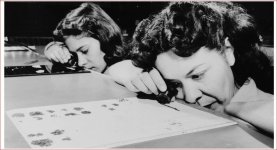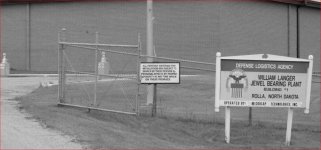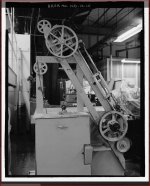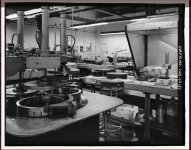Other uses for jewels, which continue into the present day, would include the pivot "bearings" for some dial indicators. In addition, some lab grade analog meters use jewelled pivots.
I appreciate this thread as I wear a Hamilton 992 pocket watches as my everyday watch. I have three (3) Hamilton 992's, and over the years these have required repair and regulation. These are lever-set railroad pocket watches with jewelled movements. Some few years ago, my wife dropped the stainless cased 992 (case made by an old toolmaker friend) on a hard ceramic tile floor. It broke the staff and some other damage was done. The local Bulova trained watchmaker said he was too old to work on my 992, nor could he get parts. I was in despair, and the members of this 'board saved the day. Miss Emma Jade, a contributor from Australia, referred me to "Historic Timekeepers, Inc", in Maryland. Mr. Dewitt Clark, the owner of HTI, is a very accomplished horologist and has a machine shop for making tooling as well as smaller machine tools for making actual watch parts. I've been sending my pocket watches to Mr. Clark ever since.
In 2007, I tangled up with two deer while riding home from the powerplant one evening on my Harley. I wound up with a small broken bone in my hand, no road rash, no bruising, no sprains nor strains. Unfortunately, my Hamilton 992 stainless cased watch did not fare so well. I took it to the local watchmaker- the Bulova trained guy. He repaired the watch, and it ran fine for a few years until my wife dropped it on the laundry room floor. This is when I was introduced to Historic Timekeepers, Inc.
Mr. Clark repaired my 992, and in the process let me know the local watchmaker had done less than a good job when he repaired it after my motorcycle accident. Apparently, the local guy did not have the correct jewel, or maybe had the wrong staff, so used a jewel to fit that pivot. Either way, the local guy had "cemented" an incorrect jewel into place. That the watch ran and kept time says a lot for his cob-job repair as well for Hamilton's 992 movements.
Mr. Clark sent me the jewel he removed when he returned my watch after repairing it. He said he had a supply of New-Old-Stock Hamilton jewels, but, if need arose, could fit another jewel correctly. Seeing the jewel he removed in a little plastic envelope made me aware of just how small these parts are. Knowing how hard rubies are, as well as the small size of the jewels and the degree of precision required got me to wondering how the jewels were made. This thread at least shows the facility for making the jewels. There is a nice old film which has been made into a youtube about the Illinois Watch Company's factory and the manufacture of mechanical watches. That film, as well as a shorter advertising film made by Hamilton, show just how small some of the parts in a mechanical watch movement are.
Some of the screws used were so small that tens-of-thousands of them would fill a tablespoon. The screws which hold the cup with the jewel into the plate of a watch are quite small, but not quite so small as the ones shown in that example. The making of the jewel cups and the taking or rolling-over of the edge of the cup to hold the jewel is shown in this film. I do not recall seeing the making of the actual jewels in this film. If natural stones such as rubies were used for the jewels, would the same sort of process as diamond cutting have been used ? I.E., reading the raw stone for cleavage planes and cutting to create small "blanks" from which the jewels were then shaped ? Would diamond cutting tools have been used to shape the jewels and create the holes for the pivots ?
Over the years, I've sent my watches to Mr. Clark, and he takes great care to repair them in the best possible way. I have a 1920's Hamilton 992 which a locomotive engineer buddy gave me many years ago. It needed repair, and Mr. Clark made a point of using NOS Hamilton parts, including a NOS Hamilton jewel. I sent my buddy's pocket watches along with one of my own to Mr. Clark for repair, and he is finishing up work on my buddy's Hamilton pocket watch which is said to be a fairly rare model. Mr. Clark called me to tell me whomever had worked on that watch was a hacker, and he was having to make some parts as well as using NOS Hamilton parts.
I enjoy wearing a "real" watch in the form of a Hamilton pocket watch. Teaching a class in introductory precision measurement at the local community college last year, I opened the course with a history of measurement and how precision measurement evolved. I made a point of opening the back of my Hamilton watch to show the class that in the pre-CNC era, highly precise small mechanisms were mass produced and worked reliably and accurately enough to prevent train wrecks. With people getting the time off their phones, even the wearing of a throw-away digital watch is becoming obsolete. Mechanical watches are more the province of the collectors, or the well-to-do people who buy some high end mechanical watch like a Rolex or similar. I am something of a stubborn and proud dinosaur in many ways, so wearing a mechanical pocket watch is something natural for me. I do not take the movement in my watch nor the work to repair and adjust it for granted. Sadly, most people nowadays have no knowledge of what a mechanical watch is, and I think that being able to "tell time" on an "analog" clock or watch may even be a skill that is fading away.















